2020年人教版新目标英语九年级全册教案
- 格式:docx
- 大小:439.32 KB
- 文档页数:136
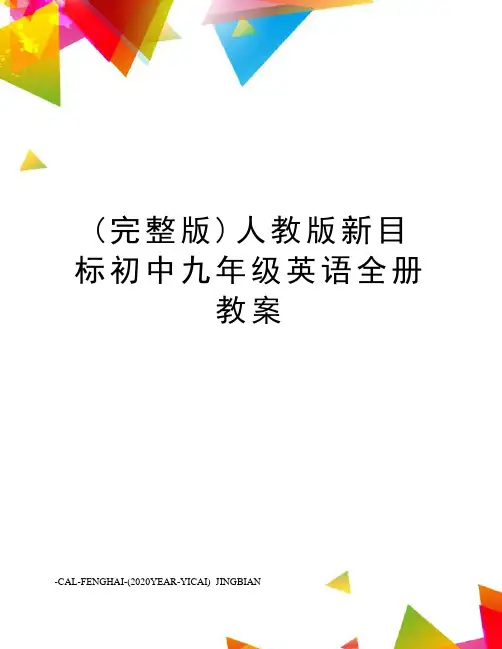
(完整版)人教版新目标初中九年级英语全册教案-CAL-FENGHAI-(2020YEAR-YICAI)_JINGBIANUnit 3 Teenagers should be allowed to choose their own clothes.Section AThe Third PeriodTarget language:A: What rules do you have at home?B: Well, I'm not allowed to go out on school nights. How about you?A: I'm not allowed to go out on school nights either. But I can study at a friend's house.教学难点Talk about agreement and disagreement.教学内容及教师活动学生活动设计意图Step 1 RevisionCompetition: Write “are allowed to” and “aren't allowed to” on the blackboard. Divide the class into groups.Each group is asked to write down as many things as they can think of about what teenagers are or aren't allowed to do. See which group can think of the most items for each category.Step 2 PresentationI.1aThis activity reviews the use of always, sometimes, usually and never.Point to the picture. Ask students to describe what is happening in the picture.Help students to say, The boy is late for class. Invite a student to read the four questions in the box to the class.Read the instructions and remind students of the exact meanings of the adverbs of frequency. Work as theteacher says.Look at thepictures and saywhat is happeningin each picture.Students finishthe task on their激发学生兴趣,对所学知识进行复习,使记忆更加深刻。
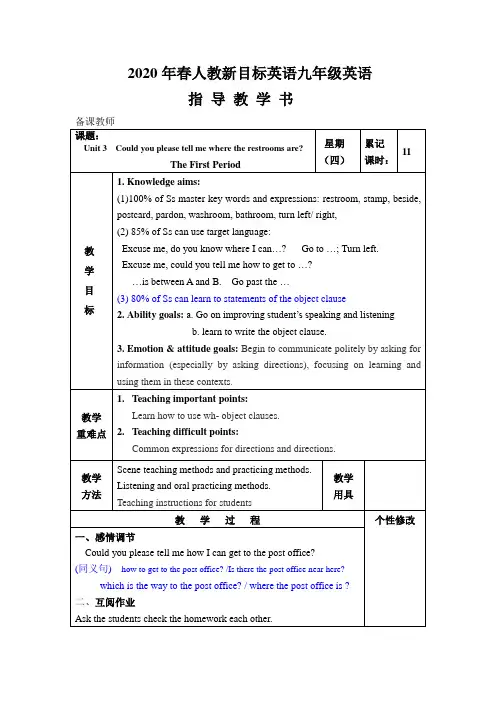
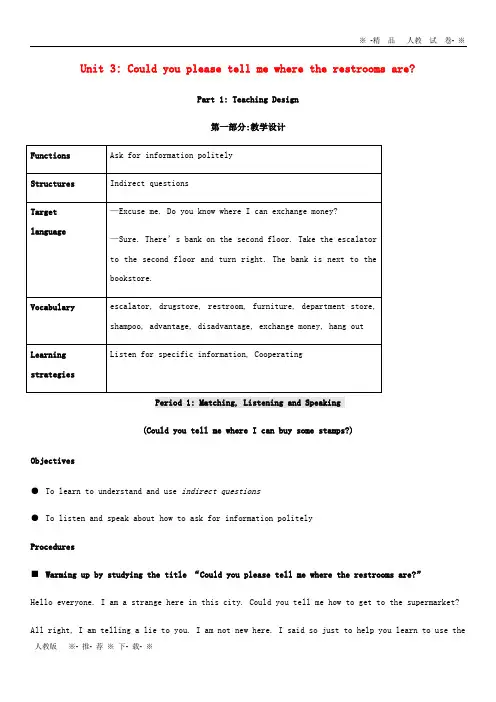
Unit 3: Could you please tell me where the restrooms are?Part 1: Teaching Design第一部分:教学设计Period 1: Matching, Listening and Speaking(Could you tell me where I can buy some stamps?)Objectives●To learn to understand and use indirect questions●To listen and speak about how to ask for information politelyProcedures■Warming up by studying the title “Could you please tell me where the restrooms are?”Hello everyone. I am a strange here in this city. Could you tell me how to get to the supermarket? All right, I am telling a lie to you. I am not new here. I said so just to help you learn to use theindirect questions.Now turn to page 87 first and look at the three sentences in the Grammar Focus.Have you noticed the word “where” and “how” used in the sentences. The questions introduced by them are called the indirect questions.Now in pairs make similar sentences with “where” and “how”.1a Looking and matchingOn page 86 is a picture of a city. A visitor is asking someone questions about things to do at certain places. Now look at the picture and match each thing with a place.1b Listening and completingIt is difficult to get around in a new place. Now listen to the recording and complete the dialogue in the picture on page 86. Write your words here in the speech bubbles.Now go to page 134 to read the tapescript.While reading try to find all the sentences used to ask for information politely, cut/ the sentence into thought groups, study all the predicates, circle all the linking words and underline all the expressions. That’s grammar study, indeed.Now try to make a conversation like the one you read just now.1c Pairing and speakingIn 1a there are many phrases describing activities. Now use them to make up conversations to talk about your own city. (The Indirect questions are darkened.)。
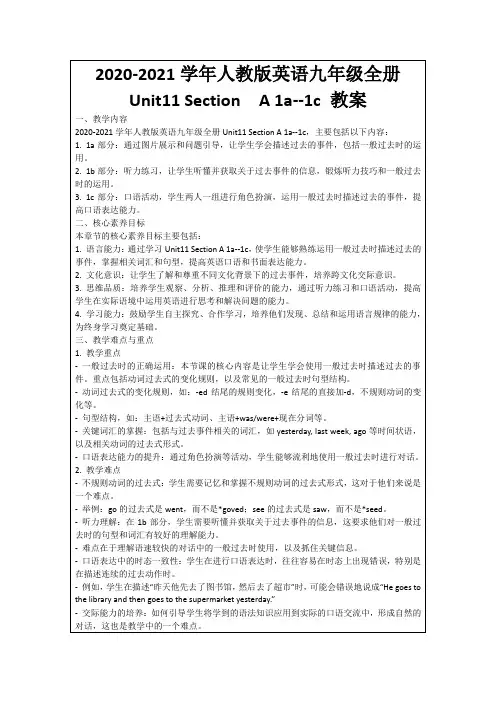
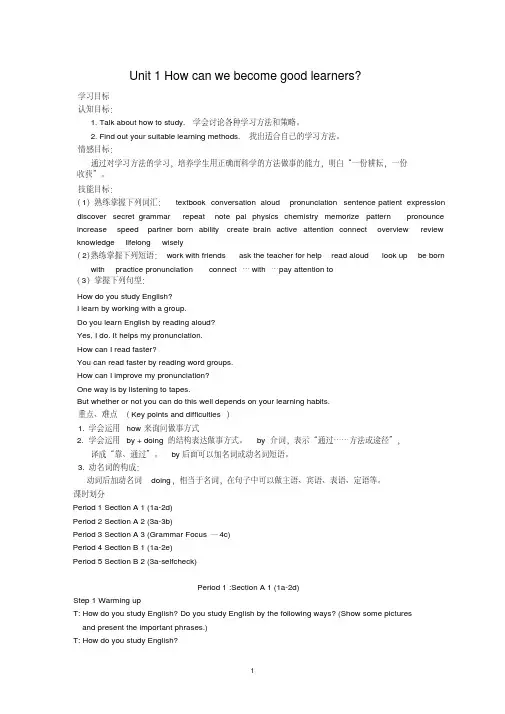
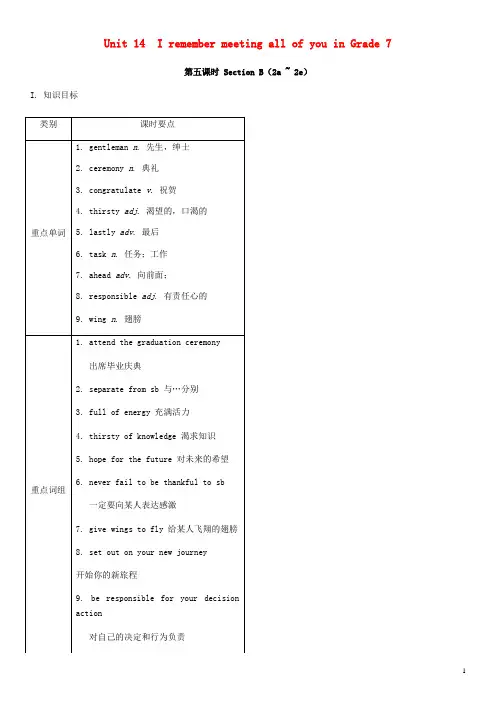
Unit 14 I remember meeting all of you in Grade 7第五课时 Section B(2a ~ 2e)I. 知识目标II. 课堂环节§自主学习方案【新词自查】根据汉语提示完成单词。
1. When I am a kid, my parents often tells me to behave like a gentleman (绅士)。
2. Jack was very stressed because he was invited to the ceremony (庆典)of his friend’s wedding.3. We went to Lily to congratulate(祝贺)her for getting the first prize in the competition.4. My sister was so thirsty(渴的)that I drink all the tea in the cup.5. Be sure of yourself and go your separate (独自的)way.§课堂导学方案Step 1 2a 情景导入(参考案例)1. 情景导入:用多媒体播放一段华中科技大学李培根教授在毕业典礼上的演讲,询问学生,毕业在际,你想结老师和母校说点什么呢?1.Have you ever attended your graduation ceremony?________________________2.What is the most important thing you have learned in Junior high school?_______________________________________________环节说明:通过上述图片或影片的介绍,使学生对这两个短文有了一定的了解,引起学习短文的兴趣。
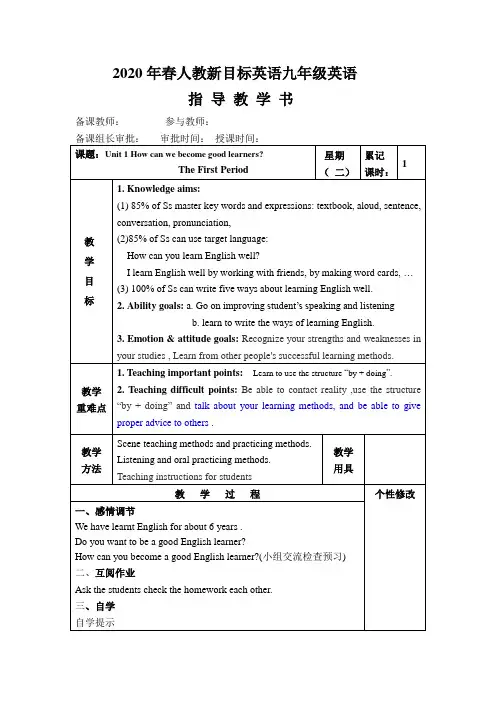
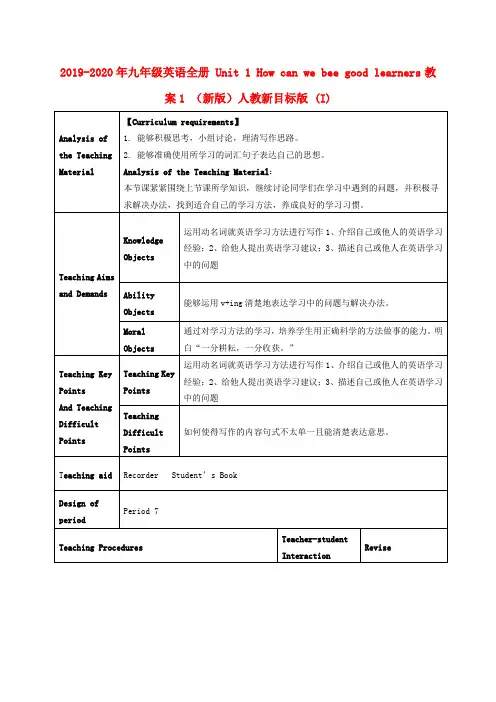
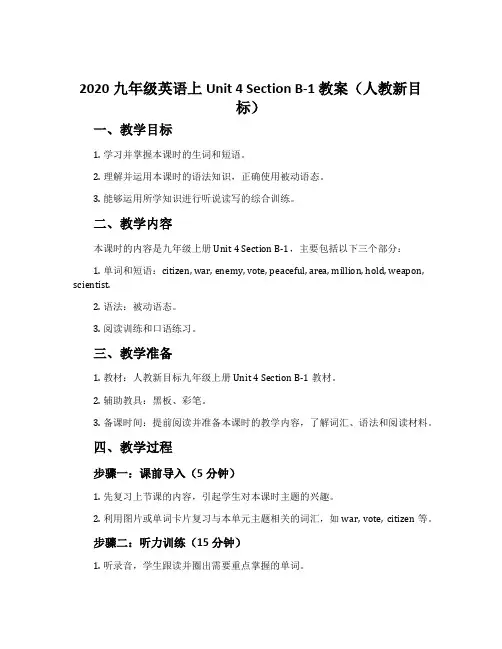
2020九年级英语上Unit 4 Section B-1 教案(人教新目标)一、教学目标1.学习并掌握本课时的生词和短语。
2.理解并运用本课时的语法知识,正确使用被动语态。
3.能够运用所学知识进行听说读写的综合训练。
二、教学内容本课时的内容是九年级上册Unit 4 Section B-1,主要包括以下三个部分:1.单词和短语:citizen, war, enemy, vote, peaceful, area, million, hold, weapon, scientist.2.语法:被动语态。
3.阅读训练和口语练习。
三、教学准备1.教材:人教新目标九年级上册Unit 4 Section B-1教材。
2.辅助教具:黑板、彩笔。
3.备课时间:提前阅读并准备本课时的教学内容,了解词汇、语法和阅读材料。
四、教学过程步骤一:课前导入(5分钟)1.先复习上节课的内容,引起学生对本课时主题的兴趣。
2.利用图片或单词卡片复习与本单元主题相关的词汇,如war, vote, citizen等。
步骤二:听力训练(15分钟)1.听录音,学生跟读并圈出需要重点掌握的单词。
2.听录音,学生回答问题,检查学生对听力材料的理解程度。
步骤三:语法讲解(10分钟)1.介绍被动语态的用法,并与主动语态进行对比。
2.分析被动语态的构成及使用情况。
–肯定句:主语 + be动词 + 过去分词 + 其他。
–否定句:主语 + be动词 + not + 过去分词 + 其他。
–一般疑问句:Be动词 + 主语 + 过去分词 + 其他?–特殊疑问句:疑问词 + Be动词 + 主语 + 过去分词 + 其他?步骤四:语法练习(15分钟)1.根据提供的句子和动词,运用被动语态进行改写练习。
2.让学生自行编写句子,使用被动语态表达。
步骤五:阅读训练(15分钟)1.学生阅读课文,并找出关键信息和重点段落。
2.学生完成课文后的相关练习,如回答问题、填写表格等。

九年级全一册英语学案及教学设计unit 1 How do you study for a test?一、教学目标1、语言目标1)询问别人的学习方法2)学习讨论各种学习方法和策略,学会评价各种学习方法的优劣2、知识目标1)How do you study for a test?I study by ving .2) the way to do sth the way of doing sthmemorize grammar frustrating quickly spoken pronounce mistakes challenge solution realize matter afraid complete impress trouble soft deal unless regard influence friendship development face基本要求:会读、会写、会用。
2、重点短语make mistakes be afraid to do sth laugh at enjoy doing sththe way to do sth English practice doing sth too much look upmake vocabulary lists try one`s best to do sth基本要求:会读、会写、会用。
3、重点语法1)How 引起的特殊疑问句及其回答2)the way to do sth the way of doing sthA● 例析导学1、They also 。
fun n. 乐趣,玩笑【拓展】1)意为―过的快活‖相当于enjoy oneself at the party 。
2)doing sth 意为―开开心心做谋事‖例如:The children are playing this game .类似的结构还有have trouble problems experience doing sth2、…and then end up speaking in Chinese .end up 结束,后接动词的v-ing形式end up with 以……结束,以……而告终例如: The game ended up with a song.【拓展】end 作名词1.端,尖,末端,终点例如:the end of the year2.边缘;极点,极限例如:the end of the road3.结局,结果。
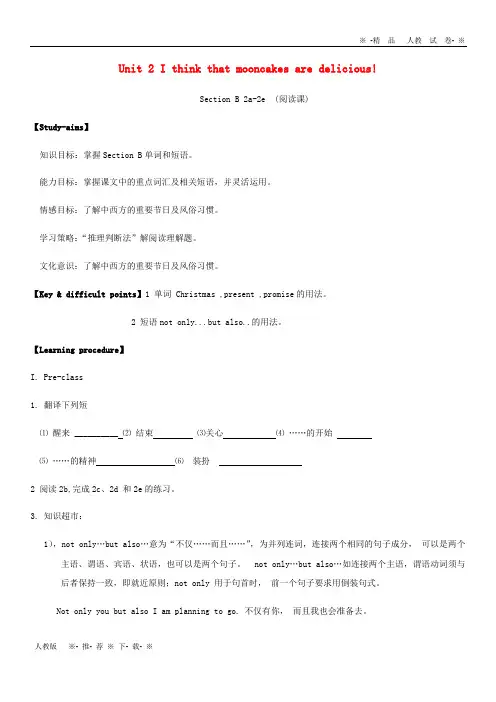
Unit 2 I think that mooncakes are delicious!Section B 2a-2e (阅读课)【Study-aims】知识目标:掌握Section B单词和短语。
能力目标:掌握课文中的重点词汇及相关短语,并灵活运用。
情感目标:了解中西方的重要节日及风俗习惯。
学习策略:“推理判断法”解阅读理解题。
文化意识:了解中西方的重要节日及风俗习惯。
【Key & difficult points】1 单词 Christmas ,present ,promise的用法。
2 短语not only...but also..的用法。
【Learning procedure】I. Pre-class1. 翻译下列短⑴醒来 __________ ⑵结束⑶关心⑷……的开始⑸……的精神⑹装扮2 阅读2b,完成2c、2d 和2e的练习。
3. 知识超市:1),not only…but also…意为“不仅……而且……”,为并列连词,连接两个相同的句子成分,可以是两个主语、谓语、宾语、状语,也可以是两个句子。
not only…but also…如连接两个主语,谓语动词须与后者保持一致,即就近原则;not only 用于句首时,前一个句子要求用倒装句式。
Not only you but also I am planning to go. 不仅有你,而且我也会准备去。
2) dress up 意为“装扮,穿上盛装”, dress up as …意为“装扮成。
;打扮成。
”。
as 后面接表示角色,职业等的名词。
He often dresses up as a farmer. 他常装扮成一个农民。
II. While-class1. 导入新课2. 教学过程⑴检查课前活动完成情况。
⑵通过阅读文章,获取具体的信息,解答问题。
⑶师生共同完成对短文的理解,呈现新知识、讲解短语。
⑷听录音,读课文。
⑸让学生根据课文的理解复述课文3. 当堂检测:⑴根据首字母写单词① The boy broke the window,, so his father p________ him.② We w__________ Japan about that Diaoyu Islands must belong to China.③ Today is my birthday and I have got a lot of p___________ from my parents. .④ We must do something useful to stop the s____________ of H7N9.⑤ The sun gives us w__________ and light.⑵用所给词的适当形式填空① We expect him _______________(come)back soon.② He warns Tom _____________ (change)his lifestyle.③ He is so _________(scary)that he wakes up in his bed.④ The picture reminded me of my ___________(child)in the countryside. .⑤ I admire him because of his ___________(kind)4. 小结:Ⅲ Blackboard DesignⅣ. Post-class1作业:背诵本课时重点词汇、短语、句型。
2020年春人教新目标英语九年级英语乌恰县实验中学教学教案1.by doing sth2.by working with a group通过同小组一起学习3.by making word cards通过制作单词卡片4.by listening to tapes通过听录音磁带5.by asking sb for help通过向某人求助6.by watching videos/ English programs通过看录像/英文节目7.by listening to a tape and repeating out loud 通过听录音和大声重复朗读8.by having conversations with friends通过和朋友一起会话9.by taking notes, doing exercises and reading a lot 通过记笔记、做大量的练习和阅读10.by writing e-mails to my pen pals通过给笔友写电子邮件11.by reading books and newspapers 通过读书看报12.by speaking English with my classmates 通过和同学讲英语13.by memorizing sentence patterns 通过记句型14.by doing grammar exercises 通过做语法练习15.by reading English books/magazines. 通过阅读英文书籍和杂志16.by writing in an English diary 通过写英文日记17.by using an English dictionary 通过用英语字典18.have conversations with sb同某人谈话19.too...to..太...而不能...---so…that…/ enough to do sth 的转换20.give a report作报告21.at first起初22.word by word逐词逐句地bit by bit 一点一点地23.the secret to language learning 学习语言的秘诀24.be afraid to do sth害怕做某事(过程)=be afraid that+宾语从句be afraid of sth / doing sth 害怕…(结果)25.an English movie called Toy Story一部名叫《玩具故事》的英文电影26.fall in love with爱上...27.body language肢体语言28.as well也=too ;as well as 如同、和,连接主语时如同with(主谓一致要看前一主语,不能相加)29.a piece of cake小菜一碟;很容易的事30.It serves you right.活该,自作自受31.look up查阅;查找(主考点)look them up 查找它们32.so that以便;为了33.repeat out loud大声跟读34.sentence patterns句型35.spoken English英语口语speaking skills 说话技能36.make mistakes in doing sth 在...方面犯错by mistake 错误地mistake …for …把……误认为……37.the ability to do sth做某事的能力38.depend on视...而定;取决于;依靠39.pay attention to注意;关注40.connect...with... 把...和...连接或联系起来41.get bored感到厌烦42.try to do sth尽力做某事43.be stressed out焦虑不安的44.even if 即使45.think about 考虑;think of 想起;think over仔细考虑46.learn from 向……学习47.something new / interesting 新事物/有趣的东西48.be born with 天生具有49.Practice makes perfect.熟能生巧50.read aloud to practice pronunciation 大声阅读练习发音51. taking notes 做笔记52.finish doing sth. 完成做某事66. think about doing sth.=consider doing sth. 考虑做某事53.practice doing sth. 练习做某事67. write down 写下,记下write to..... 写给....54. enjoy doing sth. 喜欢做某事68. each other 相互55. keep doing sth. 坚持做某事69.explain .......to........为.....解释.......56. learn a lot 学到很多learn a little 学到一点57. more than = over 超过,多于less than 少于58. the + 比较级,the + 比较级。
——教学资料参考参考范本——2019-2020学年度九年级英语全册 Unit 12 Life is full of the unexpected教案(新版)人教新目标版______年______月______日____________________部门第一课时Section A (1a-2d)【语言知识目标】1.掌握下列单词和短语:unexpected,backpack,oversleep,ring,by the time,give...a lift2.理解并掌握下列句子:By the time I got up, my brother had already gotten in the shower.But before I got to the bus stop, the bus had already left.3.掌握语法:过去完成时【情感与态度】It’s a good habit to go to bed early in the evening and get up early in the morning.So you’ll never be in a hurry in the morning.【策略与意识】Listen for specific information.Cooperating.【教学重点】1. Train the students to narrate past events with the Past Perfect Tense.2. Train the students to understand the target language in spoken conversation.【教学难点】学会使用过去完成时。
Step 1 Warming up1. Check homework.2. New words(1)Read the new words together.(加强读音训练)(2)Ask some individuals to read the new words.(发现读音问题,正音)(课前朗读可使学生快速进入学习状态,养成良好的学习习惯。
人教版新目标九年级上册英语全册教案集Unit 1 How do you study for a testPart 1: Teaching design (第—局部:教学设计)Structures: verb+by with gerundTarget language:How do you study for testWell, I study by working with my classmates.Have you ever studied with a groupYes, I have. I’ve learned a lot that way.I don’t have a partner to practice English with.Maybe you should join an English club.Vocabulary: flashcard, take notes, frustrating, memorize, aloud, comma, make mistakes, pronunciation, be afraid to, What about…Why don’t you…Learning strategies: Personalizing, Role playingSection AGoals●To talk about how to study●To read about how to studyProceduresWarming up by greetingHello, everyone!From now on you are a ninth grader. Congratulations to you and I wish you a great success in your studies!Today we shall take up the first unit in this new term, Unit 1 How do you study for a testLook at the blackboard and read after me the target language for this unit. When you read pay attention to the structure of the sentence.▲How do you study for test▲Well, I study by working with my classmates.▲Have you ever studied with a group▲Yes, I have. I’ve learned a lot that way.▲I don’t have a partner to practice English with.▲Maybe you should join an English club.Learning to Learn is very important. And learning to pass a test is also very important to you.Learning couldn’t be easier!If you have not developed good ways or methods to study for a test, talk to your classmates about it, your parents, or the teacher like me if you are brave enough. You should be brave enough to talk to others about your problems with your studies.Next I’d like to give you some useful practical advice about studying for a test and also ask you questions to make you think about things such as:▲using your time effectively▲motivation▲how to learn your lessons in the ninth grade year▲different modes of teaching you may meet▲how to develop particular skills, such as note-taking in class 1A: Checking the ways you studyNext turn to page 2 and check √ the ways you study for an English test. Then add other ways you use sometimes.▲How do you study for a testI study for a test___By reading to the tape; By underlining the expressions; By reading beyond the text; By doing used exam papers; By going over exercises books; By copying down the text; By learning the text by heart; By speakingwith classmatesNow raise your hand and report your added ways to the class. I will make a list of all the added ways on the blackboard.1b Listening and writingListen to understand how these people in the picture on page 2 study for a test. Write letters from the pictures. While listening, pay attention to the structures of the sentences.Section A 1b TapescriptBoy1: Hey, gang. There’s a big test on Tuesday. I really need some help. Can you tell me how you study for a big testVoices: Sure! Yes. Sure we will.Boy1: You did really well on the last English test, didn’t you, Mei Girl1: Yeah, I did OK.Boy1: Well, how did you study?Girl1: By making flashcards.Boy1: Maybe I’ll try that. How did you study, PierreBoy2: By asking the teacher for help. She was really happy I asked.Boy1: That’s interesting. How do you study, AntonioBoy3: I like to study by listening to cassettes. But sometimes mymother thinks I’m listening to music. And then she gets mad.Boy1:Oh, well…1c Doing a pairworkNow in pairs ask your partner how he or she studies for a test.A: How do you study for a testB: I study by working with a group.C: I study by listening to English.D. I study by playing games with my classmates.E. I study by doing actions such as coloring, matching.F. I study by singing English songs.G. I study by writingletters and emails.H. I study by acting out simple dialogues.I. I study by listening to and understanding stories.J. I study by writing simple sentences.K. I study by imitating from the recording.L. I study by speaking out words or phrases.M. I study by doing simple role plays.N. I study by reading and understanding simple stories.O. I study by using daily expressions.P. I study by performing short plays.Q. I study by performing simple rhymes.R. I study by writing sentences for pictures.S. I study by writing out simple poems.T. I study by reading aloud correctly.U. I study by playing text plays.V. I study by working with classmates.W. I study by going over the text before class.X. I study by copying words and expressions.Y. I study by looking and saying.Z. I study by asking others questions.2a Listening and checkingNow let’s go to page 3. Listen to the tape and check the questions you ask.While listening, pay attention to the structures of the sentences.Section A 2a, 2b TapescriptGirl1: Welcome to the English club. Today we’re going to talk about the best ways to learn English. Who has an ideaBoy1: Do you learn English by watching English-language videos Girl2: No. It’s too hard to understand the voices.Boy1: What about keeping a diary in English Do you learn English that wayGirl2: I think so. It helps to write English every day.Girl3: Have you ever studied with a groupGirl2: Yes, I have! I’ve learned a lot that way.Girl1: Do you ever practice conversations with a friendGirl2: Oh, yes. It improves my speaking skills.Boy1: What about reading aloud to practice pronunciationGirl3: I do that sometimes. I think it helps.Boy2: I do too. And I always look up new words in a dictionary.Girl3: That’s a great idea!2b Listening and matchingListen again and match each question from 2a with an answer in the box on page 3.2c Doing a pairworkNext we are going to make a conversation in pairs using the information from activities 2a and 2b.A: Have you ever studied with a groupB: Yes, I have. I’ve learned a lot that way.A: Have you ever learned English by watching videosB: Yes, I have. I’ve learned a lot that way.A: Have you ever practiced conversations with friendsB: Yes, I have. I’ve learned a lot that way.A: Have you ever listened to tapesB: Yes, I have. I’ve learned a lot that way.A: Have you ever read aloud to practice pronunciationB: Yes, I have. I’ve learned a lot that way.3a Reading the article and completing the chart1.Reading to the tapeWe are going to read the article on page 4. First we shall read to the tape together. That is, we start reading aloud as the recorder goes, and we stop reading aloud as the recorder stops. While reading, let’s pay enough attention to the pauses, the pronunciation and the intonation of the native reader. Make our reading aloud as the same as the reader’s.2.Reading and dividing the article into partsNext we are going to read aloud the article slowly and clearly. We will try to divide it into thought groups.3.Reading and underliningWe shall read the article once again, this time, to underline all the useful expressions in it. After school, you are going to write them down in your notebook.This week/ we asked students/ at New Star High School/ about the best ways/ to learn more English. Many said/ they learnt/ by using English. Some students had more specific suggestions. Lillian Li, for example, said/ the best way/ to learn new words/ was by reading English magazines. She said that/ memorizing the words of pop songs/ also helped/ a little. When we asked about studying grammar/ she said, “I never study grammar. It's too boring.〞Wei Ming feels differently. He's been learning English/ for six years/ and really loves it. He thinks/ studying grammar /is a great way/ to learn a language. He also thinks that/ watching English movies/ isn't a bad way/ because he can watch the actors/ say the words. Sometimes, however, he finds watching movies/ frustrating/ because the people speak too quickly.Lin Chang said that/ joiningthe English club/ at school/ was the best way/ to improve her English.Students get lots of practice/ and they also have fun. She added that/ having conversations/ with friends/ was not helpful/ at all. ;We get excited/ about something/ and then/ end up speaking/ in Chinese,〞 she said.4.Translating and completing the chartBecause you have read this article many times you are going to translate it into Chinese first and then complete the chart on page 4.Who will be the first to have a tryWays of learning EnglishNot successfulOKSuccessfulLillian LiStudying grammarmemorizing the words of pop songsreading English magazinesWei Mingwatching movieswatching English moviesstudying grammar Liu Changhaving conversations/ with friendsjoining the English club3b Doing a pairworkSilence, please! We are going to have a role play in pairs. One of the pair is to be one of the people in 3a. The other is to interview him or her about learning English.Zhao: Excuse me, Li Hong. Could you help me with my EnglishLi: Yes, please. What’s the matterZhao: I have difficulty studying grammar.Li: Grammar I never studying grammar. I study English mostly by memorizing the words of pop songs.Zhao: No grammar at allLi: Yes, I did study grammar. But I study it by reading English magazines. I put grammar learning into reading articles. That is the best way to understand English grammar.4 Doing a pairworkTurn to page 4 to check √what you do to learn English in the box.Closing down by asking and answering—How did you learn English *I listened to English them every day.*I read English books many times a day.*I learned many English songs by heart.*I sang the English songs to myself.*I learned every new English word in the text.*I learn English by going to English classes.*I do English homework at school.*I read English textbooks in the evening.*I speak English very slowly.*I play computer games in English.*I read a lot of English sentences in the morning.*I do well in class English tests.*I get a lot of good advice on learning English from my teacher. *I discuss English problems with my classmates.*I follow the advice from my father.*I learn English sounds from the tape.*I use English-English dictionaries.*I listen to recordings and English-language TV.*I talk to native speakers every chance I got.*I read books in English, mostly novels.*I learn a lot of new words from English books.*I write more and more e-mail in English.*I use English more than my first language.*Most of my reading (websites and books) is in English. Section BGoals●To listen about learning English●To talk about learning English●To read about learning EnglishProceduresWarming up by reading to the recordingHello, everyone. To begin with, let’s listen and read to the recording of the text HOW DO YOU LEARN BEST That is, read aloud to the tape, as fast as the tape goes, as clearly as the native reader reads. OK Here we go!My cat speaks English.Sometimes my cat comes to me and tells me that she is hungry. Or that her leg hurts. How does my cat tell me these things I don't speak pussy-cat language.1a Reading and checkingLearning English can be both easy and difficult. What things are easy for you And what things are difficult for you Now turn to page 5, read the list on the top and check √the statements that are true for you.1b Making a listYou have read and checked the statements true for you. Now thinkand make a list of other things difficult for you, too.I don’t know how to…!1. I don’t know how to use commas.2. I don’t know how to work with others.3. I don’t know how to make flashcards.4. I don’t know how to read the textbook.5. I don’t know how to make vocabulary lists.6. I don’t know how to listen to tape.7. I don’t know how to ask the teacher for help.8. I don’t know how to study for a test.9. I don’t know how to work with a group.10. I don’t know how to watch English videos.11. I don’t know how to practiceconversations with friends.12. I don’t know how to read aloud to practice pronunciation.13. I don’t know how to learn by using English.14. I don’t know how to get more specific suggestions.15. I don’t know how to read English magazines.16. I don’t know how to learn new words.17. I don’t know how to memorize the words.18. I don’t know how to studying grammar19. I don’t know how to watching English movies20. I don’t know how to joining the English club21. I don’t know how to improve her English22. I don’t know how to get lots of practice13. I don’t know how to ask teachers about the best ways to learn more English.2a Listening and checkingPaul is a nice boy. He works hard at his English, but still has many learning challenges. Now listen to find out what challenges he has and check them in the box on page 5.Challenges to Paul at learning English1._____ can’t get the pronunciation right.2._____ forget a lot of new words.3._____ can’t understand when people talk to me.4._____ can’t understand the words in magazines.5._____ don’t get much writing practices.2b Listening and matchingNow listen again to Paul talking about his challenges at learning English and match them with the solutions listed in the box on page 5. While listening, pay attention to the structures of the sentences.TapescriptTeacher: You look worried, Paul.Boy: I am, Ms Mitchell. I’m having trouble learning English.Teacher: You said you liked English. What’s the problemBoy: I can’t get the pronunciation right.Teacher: Well, listening can help. Why don’t you borrow the teacher’s tapes You can listen to them at home and repeat the sentences that are difficult for you.Boy: That’s a good idea. But what about all the new words I forget a lot of new words.Teacher: You can always write the new words in your notebook and study them at home. You can even study in the train on the way to school.Boy: That might really help! Thanks.Teacher: Can you understand when people talk to youBoy: Well, no. Not always. Sometimes I just don’t understand what people are saying.Teacher: Why don’t you join an English language club to practicespeaking English The English club meets after school on Tuesdays and Thursdays.Boy: Maybe I’ll go. The only other problem I have is that I don’t get much writing practice.Teacher: Maybe you should find a pen pal.Boy: That sounds like a fun way to practice writing. Thanks, Ms Mitchell.2c Doing pairworkIN pairs we are going to role play conversations using the information from activities 2a and 2b.I don’t have a partner to practice English with.Maybe you should join an English language club.I can’t get the pronunciation right.Listening can help.I forget a lot of new words.Write the new words on cards and study them daily.I can’t understand when people talk to me.You can join an English club to talk to people more in English.I can’t understand the words in magazines.You can look them up ina dictionary.I don’t get much writing practices.Start writing an English diaryevery day.I read very slowly.You should read to the recording of the text.I make mistakes in grammar.Why don’t study the basic sentence patterns3a Reading and cuttingIt’s time to read the text HOW I LEARN ENGLISH. Now read and check (/) the sentences.We are going to read the text again to study the form and function of all the predicate verbs.How I learned to learn EnglishLast year/ my English class/ was difficult/ for me. First of all, it wasn't easy/ for me/ to understand the teacher/ when she talked to the class. To begin with, she spoke/ too quickly, and I couldn't understand every word. Later on, I realized that/ it doesn't matter/ if you don’t understand /every word. Also/ I was afraid to speak/ in class, because/ I thought/ my classmates/ might laugh at me. I couldn't always make complete sentences, either. Then/ I started to watch English-language TV. It helped/ a lot. I think that/ doing lots of listening practice/ is of the secrets of becoming a good language learner. Anotherthing/ that I found/ very difficult/ was English grammar. So/ I decided to take lots of grammar notes/ in every class. Then/ I startedto write my own original sentences/ using the grammar/(that) I was learning. It’s amazing/ how much/ this helped. Now/ I am enjoying learning English/ and I got an A/ this term. My teacher is very impressed.Next we shall read the text for the third time to underline all the useful expressions. After class you are to copy them into your notebook.All right, read the text the fourth time and circle all the signal words, or the linking words which connect all the short sentences.Now you may read the statements in the box on page 6 following the text. Write “T〞 or “F〞 beside each statement.3b Writing a letterYour friend Lin Feng is having difficulties with her English. Write her a letter telling her how to become a better English learner.Dear Lin Feng,I know it isn’t easy to learn English, but I have some ideas that may help. You said you couldn’t understand people who talked fast. Well, you can try to listen for the most important words, not every word. It is difficult to understand by listening what you have not read or what you can’t understand well by reading. To listen well you have to read well. So keep on reading English. Listening and reading to the recording of the text is very important, too. Every text, after being read, should be listened to and read aloud to the tape. At first you may find itdifficult to follow the reader reading aloud the text. Don’t worry. If you keep practicing you will be able to read aloud as fast as the native reader from the tape. And then you can understand people who talk fast in English.Yours,Tai Zuo3c Writing an articleYou have been learning English for at least three years. That is such a long time. Now think about the things that have helped you the most in learning English. Write an article telling others about them.4 Doing an interviewNext we shall do an interview in groups of four. Ask the three group mates about learning English. Take notes of what they say. Tomorrow you shall stand to tell the class about their answers.Q. What isn’t easy about learning EnglishA. Reading is not easy.Q. What do you do about thisA. I try to cut the sentences into thought groups.Q. What is your favorite way to learn more EnglishI read and read aloud a lot. These are the best way.Closing down by singTo end this period let’s sing an English song.Rain, rain, go away,Come again another day,Little JohnnyWants to play.Rain, rain, go to Spain,Never show your face again.SELF CHECK1.Filling in the blankWe shall make a check on our use of expressions first. Turn to page 7 and fill in each blank with the correct word given. Change the form of the word if necessary. Then make your own sentences with each word.Complete the sentencesMake your sentences1. You should write down new English words in a vocabulary list.Don’t trust your memory. Write it down.2. If you don’t know how to spell new words, look them up in a dictionary.I don’t know how to spell your name.3. The best way to improve your English is to join an English club. I’d like to join the school football tea.4. Another thing that he find very difficult was English grammar.I find it easy to learn English.5. This kind of paper feels very soft.Do you feel cold2.Writing an articleTurn to page 7 and write an article about Xu Zheng using the notes on Xu and his essay.Xu Zheng: a boy fond of EnglishMost people in the world speak English as a second language. And so does Xu Zheng.Yesterday I asked Xu Zheng about his ways to learn English. He said he learns by making up conversations and speaking to friends in English. When I asked about studying pronunciation, he said he spent much time on it, but he still found native speakers’ pronunciation difficult to learn.I said to him, “You are a computer student. Why are you so interested in English〞“English popular in science. And it is popular around the world for computers,〞 he told me. “I likewriting notes, watching movies and listening to pop songs. But I like reading in English online most, 〞 added he.Xu Zheng is right. English can really help us understand many newthings from other countries. Let’s learn from Xu Zheng. Let’s be fond of English, too.IReading: How do we deal with our problemsAs English is learned mostly through reading in China, we shall now turn to page 8 to learn to read the article entitled: How do we deal with our problemBefore reading, please go over the vocabulary list for reading on page 146. Get yourself familiarized with all the words and expressions to be found in the article.While reading try to divide the sentences into thought groups and underline all the expressions useful to you. While you are reading it for the second time, try to circle all the linking words and try translating the text into Chinese.How do we deal with our problemRich or poor, young or old, we all have problems. And unless we deal with our problems, we easily become unhappy. Worrying about our problems can affect how we do at school. It can also influence the way we behave with our families. So how do we deal with our problems There are many ways.By learning to forgetMost of us have probably been angry with our friends, parents or teachers. Perhaps they said something you didn't like, or you feltunfair. Sometimes, people can stay angry for years about a small problem. Time goes by, and good friendships may be lost.When we are angry, however, we are usually the ones affected. Perhaps we have seen young children playing together. Sometimes they have disagreements, and decide not to talk to each other. However, this usually does not last for long. This is an important lesson for us: we can solve a problem by learning to forget.By regarding problems as challengesMany students often complain about school. They might feel they have too much work to do sometimes, or think the rules are too strict. We must learn how to change these ;problems; into ;challenges;. Education is an important part of our development. As young adults, it is our duty to try our best to deal with each challenge in our education with the help of our teachers.By thinking of something worseBy comparing yourself to other people, you will find your problems are not so terrible. Think about Stephen Hawking, for example, a very clever scientist, who regards his many physical problems as unimportant. He can't walk or even speak, but he has become very famous and successful. We are probably quite healthy and smart. Let's not worry about problems. Let's face the challenges instead.After reading, copy the underlined expressions into your PhraseBook as home.Expressions from How do we deal with our problemrich or poor, young or old, have problems, deal with one’s problems, become unhappy, worry about one’s problems, do well at school, influence the way, behave well with…, deal with one’s problems, be angry with…, feel unfair, stay angry for years about…, time goes by, lose good friendships, see… playing together, have disagreements, talk to each other, last for long, an important lesson for…, solve a problem by learning to forget, regarding problems as challenges, complain about school, have too much work to do, the rules are too strict, change…into…, an important part of one’]s development, as young adults, be one’s duty, to try one’s best, to deal with…in one’s education, with the help of…, thinking of something worse, comparing…to…, find one’s problems, think about…, for example, a very clever scientist, regards…as unimportant, become very famous and successful, worry about…, face the challenges Part 2: Teaching Resources (第二局部:教学资源)Tips for BeginnersYou are like a new babyBabies learn their language slowly.First they learn to listen.Then they learn to talk.Finally, they can read and write. Listen to English every dayListen to English radio.Watch English TV.Go to English movies.Use online lessons.Make an English/ESL friendMake up conversations.Practice dialogues.Usebeginner textbooks.Read English storiesStart with children's storybooks.Try ESL readers.Read advertisements, signs and labels. Try EnglishClub for Young Learners. Write down new wordsStart a vocabulary (new word) notebook.Write words in alphabetical order (A...B...C...). Make example sentences.Always use an English-English dictionary first. Keep an English diaryStart with one sentence.How do you feelHow is the weatherWhat did you do todayWrite another sentence tomorrow.Visit an English speaking countryLearn English more quickly.Stay with an English family.Hear native speakers talk.Have a fun experience.Unit 2 I used to be afraid of the dark.Part 1: Teaching design (第—局部:教学设计) Structures: used toTarget language:Mario used to be short.Yes, he did. Now he’s tall.I used to eat candy all the time.Did youYes, I did. And I used to chew gum a lot.Vocabulary: used to, dark, spider, insectLearning strategies: Brainstorming ComparingSection AGoals●To learn about the use of used to●To talk about what you used to be likeProceduresWarming up by learning “used to 〞Hi, everyone. Today we’re going to study Unit 2. Its title is I used to be afraid of the dark. In the title we find a phrase“used to 〞. What does it mean How is it used in Englishused to的用法“used to加不定式〞表示过去常常干某事,现在不在干了。
九年级英语:全一册英文版教案Unit 1How can we become good learners?Language Goal【语言目标】Talk about how to study Knowledge Goals【知识目标】Key Words textbook,conversation,aloud,pronunciation,sentence,patient,expression,discover,secret,grammar,repeat,note,physics,chemistry,pronounce,increase,speed,partner,born,ability,create,brain,active,attention,connect,review,knowledge,wiselyKey Phrases look up,ask sb.for help,fall in love with,be born with,pay attention to,connect…withKey Sentences1.—How do you learn English?—I learn by studying with a group. 2.—Do you learn English by reading aloud?—Yes,I do.It helps my pronunciation.3.—How can I read faster?—You can read faster by reading word groups. 4.—How can I improve my pronunciation?—One way is by listening to tapes.Key Grammar Learn to use “verb+by doing(gerund)” to express waysof doing things.Ability Goals 【能力目标】1.Develop listening,speaking,reading and writing skills byusing the target languages.2.Learn to talk about ways of studying,give suggestions to help others overcome their obstacles in study and discuss how to learn better using “by doing sth.”.Moral Goals 【情感目标】1.With the help of this unit's study,students can think and learn how to study English and they will be encouraged to be active and hard-working learners.2.Learn to communicate and cooperate with others instudy.Teaching Time【课时】Five periodsPeriod 1 Section A(1a-2d) Period 2 Section A(3a-4c)Period 3 Section B(1a-1e)Period 4 Section B(2a-2e)Period 5 Section B(3a-3b) & Self Check本单元围绕学习的话题,讲述了学习的障碍及对应的解决方法,对学生的学习有重要意义。
2020年⼈教版新⽬标英语九年级上册优质教案(全册)Unit 1 How can we become good learners?学习⽬标认知⽬标:1. Talk about how to study. 学会讨论各种学习⽅法和策略。
2. Find out your suitable learning methods. 找出适合⾃⼰的学习⽅法。
情感⽬标:通过对学习⽅法的学习,培养学⽣⽤正确⽽科学的⽅法做事的能⼒,明⽩“⼀份耕耘,⼀份收获”。
技能⽬标:(1)熟练掌握下列词汇:textbook conversation aloud pronunciation sentence patient expression discover secret grammar repeat note pal physics chemistry memorize pattern pronounce increase speed partner born ability create brain active attention connect overview review knowledge lifelong wisely(2)熟练掌握下列短语:work with friends ask the teacher for help read aloud look up be born with practice pronunciation connect…with… p ay attention to(3)掌握下列句型:How do you study English?I learn by working with a group.Do you learn English by reading aloud?Yes, I do. It helps my pronunciation.How can I read faster?You can read faster by reading word groups.How can I improve my pronunciation?One way is by listening to tapes.But whether or not you can do this well depends on your learning habits.重点、难点(Key points and difficulties)1. 学会运⽤how来询问做事⽅式2. 学会运⽤by + doing的结构表达做事⽅式。
Unit 1 How can we become good learners?学习目标认知目标:1. Talk about how to study. 学会讨论各种学习方法和策略。
2. Find out your suitable learning methods. 找出适合自己的学习方法。
情感目标:通过对学习方法的学习,培养学生用正确而科学的方法做事的能力,明白“一份耕耘,一份收获”。
技能目标:(1)熟练掌握下列词汇:aloud pronunciation discover repeat note pronounce increase speedpartner create active connect review knowledge wisely born attention (2)熟练掌握下列短语:work with friends ask the teacher for help read aloud look uppractice pronunciation connect…with… pay attention to (3)掌握下列句型:How do you study English? I learn by working with a group.Do you learn English by reading aloud? Yes, I do. It helps my pronunciation.How can I read faster? You can read faster by reading word groups.How can I improve my pronunciation? One way is by listening to tapes.But whether or not you can do this well depends on your learning habits.重点、难点(Key points and difficulties)1. 学会运用how来询问做事方式2. 学会运用by + doing的结构表达做事方式。
by 介词,表示“通过……方法或途径”,译成“靠、通过”。
by后面可以加名词或动名词短语。
3. 动名词的构成:动词后加动名词doing,相当于名词,在句子中可以做主语、宾语、表语、定语等。
课时划分Period 1 Section A 1 (1a-2d)Period 2 Section A 2 (3a-3b)Period 3 Section A 3 (Grammar Focus—4c)Period 4 Section B 1 (1a-2e)Period 5 Section B 2 (3a-selfcheck)Unit 1 Section A 1 (1a-2d)Step 1 Warming upT: How do you study English? Do you study English by the following ways? (Show some pictures and present the important phrases.)T: How do you study English?S: I study English by ______.by working with friends.by making word cards.by asking the teacher for help.by reading the textbook.by working with a group.by listening tapes.Step 2 1a Check the ways you study English. Then add other ways you sometimes study.___ a. by working with friends.___ b. by making word card.___ c. by reading the textbook.___ d. by listening to tapes___ e. by asking the teacher for help.…Step 3 Listening1) Listen. How do these students study for a test? Write letters from 1a above.2) Check the answers: b (Meiping); e (Peter); d (Tony)Step 4 GuessShow some pictures.Guess: How does he/she study English? He/She studies English by…How do they study English? They study English by…Step 5 Pairwork1c Make conversations about how you study for a test.A: How do you study for a test?B: I study by working with a group.A: How do you study for a test?B: I study by…Step 6 Listening2a Listen and check the questions you hear.1 ____ Does anyone learn English by watching videos?2 ____ Do you have conversations with friends in English?3 ____ What about listening to tapes?4 ____ What about reading aloud to practice pronunciation?5 ____ Have you ever studied with a group?Answers: 1, 2, 4, 52b Listen again. Match each answer below with a question above.a. Yes, I have. I’ve learned a lot that way.b. Oh, yes. It really improves my speaking skills.c. I do that sometimes. I think it helps.d. No. It’s too hard to understand spoken English.Answers: d, b, c, aStep 7 Pairwork1. 2c Make conversations using the information in 2a and 2bA: Have you ever studied with a group?B: Yes, I have. I’ve learned a lot that way.Show some pictures.1) A: Do you learn English by watching movies?B: Yes, it’s a very interesting way.C: No, it’s too hard to understand spoken English.2) A: What about writing letters to a pen pal in America?B: Yes, it helps to improve my writing skills and know a lot about America.3) A: Do you have conversations with friends in English?B: Of course, we can talk about plenty of things like school, pets, movies, and our parents.2. 2c Role-play the conversation.Step 8 SummaryHow do you study English?1. by working with friends2. by watching English movies.3. by making word cards.4. by reading the textbook.5. by listening to tapes.6. by asking the teacher for help.7. by reading aloud.…Step 9 Language points1. I study by working with a group.我通过小组活动来学习。
by作为介词,用法很多。
请仔细观察下面的例句,分析by的用法,然后补全结论部分所缺的内容。
【例句】1) Come and sit by us.2) Peter goes to work by bus every day.3) Tony will come back by 10:00 pm.4) English is spoken by lots of people.5) My brother studies history by working with a group.【结论】1) by可表示位置,(1) “__________”,如句1。
也有“从……旁边(经过)”之意。
2) by可表示交通、传递等的方式,如句2。
3) by可表示时间,“到(某时)之前;不迟于”,如句3。
4) by可用于构成(2) ________,“被,由”,如句4。
5) by可表示方式或手段,(3) “____________”结构在句中作方式状语,“通过……方式(方法)”或“借助……手段”,如句5。
Answers: (1) 在……旁边(2) 被动语态(3) by + V-ing形式【运用】根据提示,用含有by的短语完成各句。
1)Annie went to Beijing_______ (乘火车)yesterday.2)His grandfather made a living_________ (靠卖水果)in the past.3)The scientists have to arrive at the village_________ (八月以前).4)Allen goes_______________ (经过邮局) on his way to school every morning.5)The book was written____________ (由几个工程师).Answers: 1) by train 2) by selling fruits 3) by August 4) by the post office 5) by several engineers2. What about reading aloud to practice pronunciation?大声朗读来练习发音怎么样?辨析aloud, loud和loudlyaloud出声地;大声地。